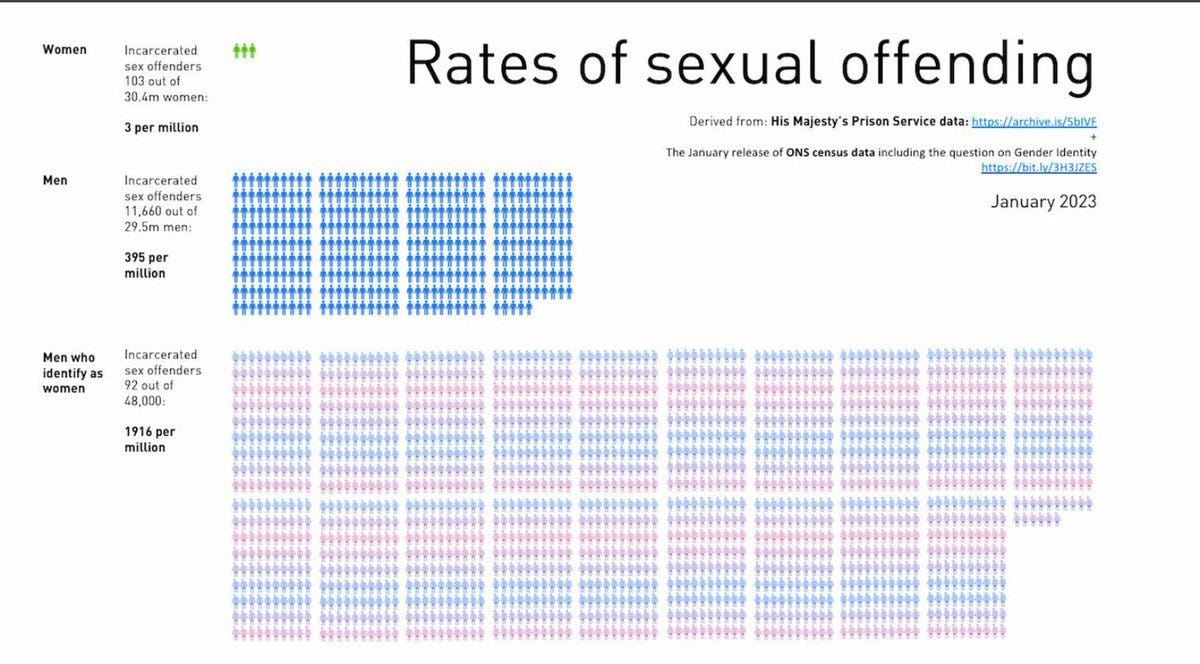The Trans Debate: Diane Yap Aug 07, 2024
If the goal is body modification financed by the individual, I’m maximally laissez-faire. If the goals infringe on the rights (or even the cognitive load) of others, that’s a different story
TEXT:
I haven’t said much publicly about transgender issues because those who are on my “side” politically (I’ve been cast as right-wing, you see) have been using it as a political football. Badly fumbling. No discipline, coming off as bigots who got the ick and want to yell about it. The truth is, I didn’t know much about the topic and didn’t want to wade in before knowing more. Now that I’ve read more, learned a few surprising facts that should be more widespread knowledge and had some time to think about it, let’s discuss.
First, let me express my relief that I did not grow up under today’s regime of gender ideology. I would have been classified as “boy stuck in a girl’s body” quicker than you could say “gender dysphoria.” Whether a person is trans appears to be determined by how closely they conform to gender stereotypes. As a child, I liked to play with cars (especially ones that changed color in hot water), dinosaurs and Legos. My favorite toy was a remote-controlled monster truck. Which I drove over my other matchbox cars. And dolls? After I pulled off their heads and limbs to see how they were attached and then reattached them, they held zero interest for me.
My mother loved to put me in frilly dresses, stockings with tiny pink hearts and patent leather Mary Janes: sending me to school looking like a porcelain doll. I hated this because one of my favorite school activities was mucking around in the dirt and mud. The other was climbing trees and jungle gyms. I’d inevitably rip my stockings or muddy my dress, resulting in quite some yelling. My solution? I started taking off my delicate clothes before going out to play, running around the preschool yard nearly-naked; a barefoot savage.
With my Legos, I’d make guns. Not just any guns, machine guns. Why? Because my dad let me watch movies like Rambo and Terminator. My friends, I didn’t just identify as male. I identified as one very specific male: Rambo. So, you see, I would’ve 100% been transed and you would know me today as “Rambo.” If a teacher offered me the deal of “You just have to say you’re a boy and we can force your mom to let you wear pants to school” I would’ve enthusiastically agreed.
But, for me at least, it would’ve been the wrong move to tell me I was actually a boy, socially transition me and put me on the path towards medical transition. All I really needed was to be sent to school in reasonable play clothes and patted on the head until my “Rambo” delusions passed. And they did. By the time I started elementary school, even I had forgotten that I once identified as Rambo.
But how common is my experience? I’m not sure. What I do know is that when adults take these pretend-play identities too seriously (even with good intentions) and socially transition their child, the progression towards medical transition becomes nearly inevitable. According to one study, 98% of children who were socially transitioned continue to experience gender identity disorder (GID) into early adolescence (age 11-12). On the other hand, without intervention, 80–95% of children who experience GID no longer do once they reach adolescence.
Similar statistics show that starting puberty blockers isn’t a neutral decision. 95% of children who go on puberty blockers escalate to cross-sex hormones and further medical intervention while 61-98% of those who do not will begin to identify as their birth gender during puberty. Not to mention the increased risk of bone density problems, suicidal ideation, and the lack of long-term data on this off-label usage of puberty blockers.
This point cannot be overstated. Here’s the crucial takeaway: social transition and puberty blockers are not neutral, reversible decisions that allow you to put off the decision. They put children on a slingshot trajectory towards medical transition — it’s nearly impossible to change course once started.
Aside from the issue of transitioning children, should we have an opinion about transgender ideology? I think a reasonable stance is, “it depends on what they want.” If the goal is body modification financed by the individual, I’m maximally laissez-faire. If the goals infringe on the rights (or even the cognitive load) of others, that’s a different story.
Subscribe
Critical Rice Theory is a reader-supported publication. To receive new posts and support my work, consider becoming a free or paid subscriber.
No, male to female (MTF) transsexuals shouldn’t have access to women’s spaces. The logic behind the existence of sex-segregated spaces doesn’t disappear when a man identifies as a woman. Women’s bathrooms, locker rooms and prisons exist because men have much higher rates of violent and sexual offending than women, and this holds true for men who identify as women.
Here, 2023 data shows that MTFs commit sex crimes at five times the rate of men and over 600 times the rate of women. A similar argument holds for women’s sports. Sports are sex-segregated because men are stronger on average and even elite female athletes are not competitive against men who are much lower-ranked amongst their male counterparts.
No, government-provided health insurance shouldn’t cover “gender affirming” treatments. They want equality? This is equality: people who were born the “correct” gender don’t receive coverage for cosmetic procedures that help them conform closer to the stereotypical appearance of their gender. There’s no meaningful sense in which existing medical technology can change a male into a female or vice versa: all we can do right now is sterilize and disfigure.
A relevant medical comparison is the recommended treatment course for body integrity identity disorder (BIID), which causes sufferers to believe that one of their limbs does not belong to them. This mismatch between perception and reality can be so strong that many BIID sufferers have attempted self-amputation — indeed, about 11% of 52 subjects in a 2004 study on BIID risked their lives to remove their own limbs. However, the current medical consensus is to deny amputation of healthy limbs even though existing medical technology can easily transform BIID patients into what they desperately want to be, what they see themselves as: amputees. Based on outcomes alone, it seems like the standard course of treatment for BIID vs transgender should be reversed.
No, they shouldn’t be able to compel anyone to use their preferred pronouns. Instead, transsexuals can take misgendering as a signal on how successful they are at passing. Isn’t that the ultimate goal? Why would they want to force others to lie about what they perceive when they could use the information to improve their chances of passing as the opposite sex?
On the other hand, if all they want is to waltz down the street in twirly dresses because it makes them feel pretty, why not? If adults want to modify their own bodies with hormones or surgeries that is their business, as long as the taxpayer isn’t footing the bill.
I recently finished Phil Illy’s book Autoheterosexual and it made me question the value of the prevailing rhetoric on transgender issues. That having feelings of gender dysphoria necessarily means you were “born in the wrong body” and the only way to be happy and live “as your true self” involves medical transitioning. What if it isn’t?
The book covers Blanchard’s two-type theory on MtF, where the two types are homosexual transexuals: naturally effeminate gay men who begin to identify as female during childhood, and autogynephilic transsexuals (AGP), who are aroused at the idea of being female — beginning around puberty. MRI studies support the two-type model, showing that the homosexual type have brains that are more “female-shifted” whereas the AGPs have brains that matched male controls.
Importantly, an estimated 75%+ of MtFs in Western countries are AGP. The upside to embracing two-type theory over the mainstream medicalized solution is that each individual can choose to interact with gender as much as it pleases them instead of feeling pressured to become a member of the opposite sex with hormones and surgeries — not that it is currently possible to do this, even with the best available medical technology.
What proponents of gender ideology and medicalized transitioning claim to support is acceptance. Ironically, they’re doing the opposite by enforcing rigid gender stereotypes. They leave no room for the man who likes wearing skirts and heels or the little girl who wants to climb trees and shoot machine guns. To them, these individuals are not living as their “authentic selves” unless they fully commit to transitioning.
The conservative anti-trans side pushes the same enforcement of gender stereotypes, for different reasons. Imagine a conservative dad who sees his son playing dolls with his little sister and snatches them from his hands, bellowing “No son of mine plays with dolls, that’s for girls!” What if that little boy liked playing with dolls? Would the conservative dad rather see his son conclude “I love playing with dolls, so I must be a girl”? Would he rather his son become his daughter instead?
“You like pink, dresses, heels, makeup and being pretty, sweet and soft? That means you’re a girl!” In my ideal world, acceptance would mean no one bats an eye if a boy liked all of those things. No one would tell him he’s really a girl for liking those things. Wouldn’t that be better? Can’t we let people like what they like without pushing them to get chemically or surgically sterilized for it?
****************************





